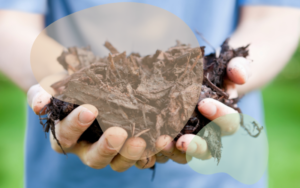A thriving garden starts with healthy soil and the right fertilizers. By understanding the basics of soil composition, texture, and fertility, and how to choose and apply fertilizers effectively, you can create the perfect foundation for your plants to flourish.
Understanding Soil
Soil is the lifeblood of your garden. It provides essential nutrients, water, and support for plant growth. Understanding the components of soil is crucial for creating a thriving garden.
Soil Composition
Soil is composed of four primary components:
- Minerals: Minerals form the backbone of healthy soil composition by supplying essential nutrients such as nitrogen, phosphorus, and potassium. These nutrients are crucial for various plant processes, including photosynthesis, root development, and overall growth.
- Organic matter: The unsung hero of your garden, organic matter is vital in improving soil structure, enhancing water retention, and boosting fertility. It provides a habitat for beneficial microorganisms and ensures that your plants receive a steady supply of nutrients over time. Examples include compost, well-rotted manure, and decomposed leaves, all of which can transform lifeless soil into a vibrant growing medium.
- Water: Often called the lifeblood of your garden, water is indispensable for every aspect of plant health. It facilitates nutrient uptake by dissolving essential minerals and delivering them to plant roots. Without adequate water, plants struggle to grow, photosynthesize, and produce fruits or flowers. Proper watering techniques—such as drip irrigation or deep watering—can make all the difference in maintaining vibrant, thriving plants.
- Air: Often overlooked but vitally important, air is essential for root respiration and the activity of beneficial soil microbes. Roots need oxygen to grow and function properly, while soil microorganisms require air to break down organic matter and release nutrients. Well-aerated soil, achieved through proper tilling, avoiding compaction, or adding organic matter, ensures your plants have the oxygen they need to thrive.
Soil Texture
Soil texture refers to the proportion of sand, silt, and clay particles in the soil:
- Sandy soils: Drain quickly but retain a few nutrients.
- Clay soils: Retain water and nutrients well but can become compacted.
- Loamy soils: A balanced mix of sand, silt, and clay, ideal for most plants.
Soil Structure
Soil structure describes the arrangement of soil particles into aggregates, which act like tiny clusters that create pathways for air, water, and roots to move through. Good soil structure not only ensures adequate drainage but also maintains proper aeration, allowing roots to breathe and grow deeply. Healthy root systems thrive in well-structured soil, leading to stronger, more resilient plants.
Soil pH
Soil pH measures the acidity or alkalinity of the soil, a critical factor for plant health and nutrient availability. Most plants thrive in slightly acidic to neutral soil, with an ideal pH range of 6.0 to 7.0. You can test your soil’s pH using a DIY kit, which is readily available at garden centres, or opt for professional soil testing services for a more precise analysis.
Soil Fertility
Soil fertility means your garden has the nutrients to support healthy plant growth. All gardeners need to know the three main nutrients plants need:
- Nitrogen (N): Boosts leafy growth and vibrant green foliage. Without it, plants can appear yellow and stunted.
- Phosphorus (P): Supports root development and flowering. Strong roots mean better overall plant health and more blooms or fruit.
- Potassium (K): Enhances plant health and stress resistance, helping plants thrive in tough conditions.
Soil Testing
Soil testing is an easy and valuable way to understand soil nutrient levels and pH. By knowing exactly what your soil needs, you can create a tailored fertilization plan that boosts plant health and maximizes yields. Whether you’re a beginner or an experienced gardener, soil testing helps you make smarter decisions to improve your garden’s success.
DIY Soil Testing Kits vs. Professional Services
If you’re looking for a quick and simple way to test your soil, DIY soil testing kits from garden centres are a great option. These kits let you check pH and nutrient levels easily at home.
For more detailed and accurate results, you can send a soil sample to a professional lab. Professional soil testing gives you a comprehensive nutrient breakdown, accurate pH levels, and tailored recommendations for soil amendments, helping you create the perfect environment for your plants.
Improving Soil Health
Organic Matter: The Backbone of Healthy Soil
Adding organic matter is essential for improving soil structure, water retention, and nutrient availability. Here are some great options:
- Compost: Nutrient-rich and easy to make at home, compost helps enrich the soil with essential elements.
- Manure: A natural fertilizer that adds nutrients and organic material, enriching soil fertility.
- Leaf Mold: Perfect for improving soil texture and boosting water retention, making it a great addition to your garden.
Additional Techniques for Soil Health
- Cover Cropping: Planting cover crops helps improve soil fertility, prevent erosion, and suppress weeds, keeping your garden healthy year-round.
- Mulching: Using organic or inorganic materials such as mulch conserves moisture, regulates temperature, and reduces weed growth, all while enriching the soil.
- Crop Rotation: Rotating crops annually prevents pest buildup and maintains soil health. This technique guarantees your plants will thrive season after season.
Choosing the Right Fertilizer
Types of Fertilizers
- Organic Fertilizers: These provide slow-release nutrients while improving soil structure and health. Examples include compost, manure, and bone meal—great for long-term fertility.
- Inorganic Fertilizers: Ideal for a quick nutrient boost, they are formulated to address specific deficiencies. However, overuse can harm soil health over time, so use them sparingly and wisely.
NPK Ratios
The NPK ratio indicates the percentage of nitrogen (N), phosphorus (P), and potassium (K) in the fertilizer. Choose an NPK ratio based on your plants needs or identified soil deficiencies. For example, a 10-10-10 fertilizer offers a balanced blend, while a 20-10-10 is better for nitrogen-hungry plants like leafy vegetables. Tailoring your fertilizer choice ensures better results!
Slow-Release vs. Quick-Release Fertilizers
- Slow-Release Fertilizers: These release nutrients gradually over time, providing a steady supply for plants while reducing the risk of nutrient burn. They are ideal for long-term feeding and require less frequent application.
- Quick-Release Fertilizers: Perfect for a fast nutrient boost, these deliver immediate results but need more frequent applications. Be cautious, as overuse can lead to nutrient runoff and potential soil damage.
Choosing between the two depends on your plant’s needs and how much maintenance you are comfortable with. For consistent growth with less effort, slow-release is often the better choice.
Liquid vs. Granular Fertilizers
- Liquid Fertilizers: Easy to apply and absorbed quickly, liquid fertilizers are perfect for fast-acting results. They are great for addressing nutrient deficiencies or giving plants a quick boost during their growth stages.
- Granular Fertilizers: Applied to the soil, these are designed for slow, long-term feeding. They are durable, less prone to leaching, and ideal for gardeners seeking low-maintenance options.
Fertilization Techniques for Healthy Plants
- Top Dressing: Simply spread fertilizer evenly on the soil surface. This method works well for established plants and lawns, allowing nutrients to seep into the soil gradually.
- Side Dressing: Apply fertilizer close to the base of growing plants for a targeted nutrient boost. It is especially effective for crops like tomatoes and corn.
- Foliar Feeding: Spray liquid fertilizer directly onto plant leaves for rapid nutrient absorption. Ideal for addressing deficiencies quickly.
- Fertigation: Combine fertilization with irrigation by delivering nutrients through your watering system. This precision method ensures even distribution and is excellent for larger gardens.
Common fertilizing mistakes
Overfertilizing: Overfertilizing can damage plants and harm the environment. Symptoms of overfertilization include burned leaves, stunted growth, and nutrient imbalances.
Underfertilizing: Underfertilizing can lead to poor plant growth, yellowing leaves, and reduced fruit or flower production.
Improper Timing of Fertilization: Applying fertilizer at the wrong time can be ineffective or harmful to plants. Always follow the instructions on the fertilizer label, or consult with your local specialist.
Incorrect Application Methods: Using the wrong application method can lead to nutrient loss, soil damage, and plant injury.
Troubleshooting Common Soil Problems
Compacted Soil: Compacted soil can restrict root growth and reduce water and nutrient uptake. Aeration techniques, such as core aeration or tilling, can help improve soil structure.
Poor Drainage: Poor drainage can lead to waterlogged soil, which can suffocate plant roots. Improving drainage can be achieved through raised beds, drainage tiles, or amending the soil with organic matter.
Nutrient Deficiencies: Nutrient deficiencies can cause various symptoms, such as yellowing leaves, stunted growth, and poor flowering. Soil testing can help identify specific nutrient deficiencies, which can be corrected through fertilization.
Pest and Disease Problems: Healthy soil can help plants resist pests and diseases. However, if problems arise, identify the specific pest or disease and take appropriate control measures.
Sustainable Gardening Practices
- Reduce Fertilizer Use: Opt for natural fertilizers like compost and manure to nourish your plants while minimizing environmental impact. This practice supports soil health and reduces chemical runoff.
- Water-Wise Gardening: Conserve water using efficient methods like drip irrigation or soaker hoses. Mulching also helps retain soil moisture, reducing the need for frequent watering.
- Integrated Pest Management (IPM): Use a balanced approach to pest control by combining cultural practices (like crop rotation), biological controls (such as beneficial insects), and minimal chemical interventions for long-term sustainability.
A good understanding of soil and fertilizer basics can lead to a healthy foundation for your garden. Tailoring your approach to soil health, fertilization, and sustainable practices will improve plant growth and reduce environmental impact. Happy gardening🌱




